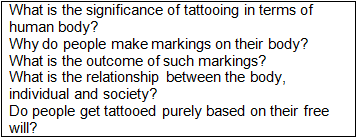
Why do people get tattoos?
People who are averse to tattoos often ask “why would you want to get a tattoo?” They clearly dislike the appearance of tattoos on the human body. But then, why do so many people get tattoos, despite the negative image associated with it? This question is relevant not only in the Korean society, but around the world. Even in western culture, where tattoos are more common, people have different opinions about tattoos. Many anthropologists have studied the phenomenon of tattoos and provided explanations.
Alfred Gell recognized tattoo as representative of a relationship between an individual’s body and the society. In his paper Wrapping in Images: Tattooing in Polynesia (1993) he observed the practice of tattooing of Polynesian tribes in the South Pacific before and after their contact with the Western civilization. He compared the relationship between authority and social stratification of different time periods.

Table 1. Alfred Gell’s questions regarding the relationship between tattooing and society.
It is true that social contexts of the past can differ from those of the modern day. However, Gell’s observation that an individual’s body is not just under his/her discretion provides an important insight into the practice of tattooing. Another in-depth study on tattooing was conducted by Makiko Kuwahara. In her paper, Tattoo, an anthropology (2005) written after her field study in Tahiti, she explains that tattoos are a basic element that distinguishes one’s body from those of the others as well as a medium through which a relationship with others is formed.
Humans form an individual and social identify through their body. In particular, changing the body such as tattooing is an active practice that forms one’s identity and defines one’s place in relation to others. Moreover, tattooing is carried out in various places and times in different levels. They represent different ideologies. This value system signifies that the attitudes and judgements regarding tattooing can change across time periods and regions. That is, the human body is treated differently according to the value systems including the view of the universe, religion, aesthetic standards, political organizations, etc. Tattooing is also related to the conflict arising from the unequal distribution of power.
[Advertisement] MAGNUM(Q-switched Nd:YAG Laser) – Manufacturer: (www.i-dana.com)]
Anthropological musings on tattoos in Korea can be found in Hyun-sul Cho’s History of tattoos (2003). In 2002, the society-wide enthusiasm for the World Cup hosted in Korea and Japan spilled over into fields other than sports. Many of the drastic changes during this period have to do with the desire to express oneself. Cho, who recognized this phenomenon, tried to find the origins of social phenomena in 2003 in history. He pointed out that tattooing was becoming a new cultural trend in the Korean society and that tattoos were not yet understood but rather despised and avoided. He tried to understand the contemporary cultural phenomena through old practices of body decorating such as piercing, body painting, flano art and tattooing observed from anthropological or folklorist perspectives. He proposed that we go beyond the prevalent prejudice against the marginal culture to see the essence of the subject.
-To be continued




















